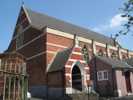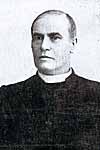 Sneinton Sneinton
St Alban
History
In 1872 the vicar of St. Stephens Church, Sneinton, Canon Hutton, and the church council decided that their church was no longer large enough to accommodate the rapidly growing population of the parish, and the decision was made to open a Mission Room on Eldon Street, probably Upper Eldon Street. Maps of that date show that this street had commercial buildings on the west side that were demolished in the 1930s. The building was rented at a cost of £33 per year, and records show that they sub-let part of it commercially.
The new venue was well used, and in the weeks before Easter the Rev. W. B. Crawford, a visiting minister, held services every evening and in Holy Week conducted special services for children from Monday to Thursday evenings at 7 p.m. By 1879 St. Stephen’s parish magazine announced that the Mission was now free from debt and financially self-supporting. The following edition of the magazine gave notice that a meeting was to be called to consider the possibility of another Mission Room on Nottintone Street and Beaumont Street adjacent to the west side of St Stephen’s church. The new building was to offer both mission and secular social facilities. It would be open every day with Sundays reserved for Sunday schools and Bible classes.
However, the operation of the new premises was not without problems, as various records reveal clashes with different sets of users, frequently regarding behaviour and noise. It was a substantial building that came to be known as the Sneinton Institute and was in regular use until it was demolished in the 1950s as part of the Sneinton slum clearance programme. During its life its use became less parochial and more social, being used by the YMCA, Boys Brigade and a snooker hall. No record has been found recording the fate of the Eldon Street Mission Room.
In February 1881 the parish magazine announced that Canon Hutton, the vicar of St. Stephen’s, had purchased a substantial piece of land then occupied by a large house and garden on Bond Street at the lower end of Sneinton Road. The site was located less than five minutes’ walk from St. Stephen’s, and the entry stated “that he intended to dedicate the land to the service of the church eventually having its own full time priest to take charge and eventually a new Church District will be formed”. The cost of the land was £2,300. Canon Hutton gave £1,000 plus a temporary loam of £300. The remaining £1,000 was raised by a loan from a friend of the church at an interest rate of 3%. The new church was to be dedicated to St Alban.
The present St. Alban’s Church was not however the first church building on the site. Initially a corrugated iron building to seat 300 people was erected and opened on the south-east corner of the site. It was designed by Truman and Platt, architects of Nottingham, and supplied by Kemp & Co. of Euston Road, London. The cost of the building was £315 excluding the foundations. It served the parish well whilst the new church was built and for several years more, until funds become available to complete the new building by the erection of St. Michael’s Chapel in 1913, the corrugated iron church having been dismantled and moved to a new site in Sutton in Ashfield.
Although a new church was planned it was considered necessary to find more immediate space for the growing congregation, and a rented room was acquired in Eldon Street, where St Stephen’s had established a Mission Room twelve years before. No further details of this venture have been found.
Building of the church progressed well and on 16 January 1887 a short ceremony was planned starting with a procession from St. Stephen’s Church to the site of the proposed new St Alban’s. Despite the heavy rain that day it was well attended, and a collection raised £32 1s. 6d. The next day at St. Stephen’s church another collection produced £6 6s. 4d. towards the cost of the new church. On 18 September 1887 during harvest festival week St. Alban’s church was consecrated by the Bishop of Lincoln.
Initially services included Holy Communion on Sundays at 7.30 am and 7.30 pm., Matins with sermon at 10.30 am and Evensong at 6.30 pm, Holy Communion on Tuesdays and Thursdays at 7am.
 Father Boag Father Boag |
Soon after the opening of the church Canon Hutton announced that he had been able to arrange the sum of £2,500 to provide an endowment for a stipend, allowing the appointment of a priest in charge. The first person to hold the post was Father Boag. A succession of priests in charge and curates from St. Stephen’s held posts; initially they lived at St. Stephen’s vicarage with Canon Hutton, but later moved into a rented house at 1 Victoria Avenue Sneinton Dale, close by St Stephen’s, and later moving 10 Dale Street, even closer to St Stephen’s. From the opening of St Alban’s Church it was, as St Stephen’s, Anglo-Catholic and a follower of the Oxford Movement.
In 1884 St Alban’s was declared a church district with a parish formed from part of the parish of St. Stephen’s and part from the parish of St. Mathias, another daughter church of St Stephen.
St Alban’s church provided a wide range of religious and social activities for its parishioners. Records from 1887 show the range of activities the church supported: a Mothers’ meeting, Bible Class, Working Men’s Social Club, district visiting, Blanket Club Provident Club, Girls’ Friendly Society, Boys’ Recreation Society, and a Working Party. In 1932 the parish magazine also listed Sunday Schools, Scouts, Rangers, Guides and Cubs plus separate meetings for Ladies and Gentlemen.
Records show that at the time of the Bishop of Southwell’s visitation in 1911, the church seating had increased to 565 and the parish population up from 3,547 in 1901 to 4,204.
The final days of St. Alban’s probably started in the mid-1950s when Nottingham City Council announced a large slum clearance programme in Sneinton. It effectively removed a large part of the parish population, re-locating residents to many different areas, some far from St Albans. Due to the low levels of attendance St Alban’s was reunited with its mother church with the title change to ‘St Stephen’s with St Alban’s’. In 1961 the vicar of St Stephen’s, the Rev. John Tyson closed St Alban’s church and transferred the building to the care of the Ukrainian Orthodox Church which still occupies it. It was not until 1993 that the building was sold to the Ukrainian Greek Orthodox Church.
The church registers are held by Nottinghamshire Archives. In 1962 the Registers were closed.
|